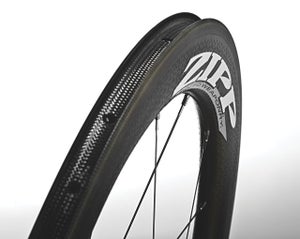New perk! Get after it with local recommendations just for you. Discover nearby events, routes out your door, and hidden gems when you sign up for the Local Running Drop.
How does carbon make for a more advanced race wheel? Chrisopher Kautz explores this topic.
Written by: Christopher Kautz
Race wheels are the best possible upgrade you can make to your current bike. High performance wheels can greatly improve how your bike handles, its aerodynamics and overall ride quality. While there are many different styles of race wheels for different types of racing, triathlon race wheels should be designed to provide an aerodynamic advantage because wind drag creates the majority of the resistance faced by a cyclist in a non-drafting triathlon.
One hallmark of aerodynamic wheels is a deeper rim than found on standard wheels. Manufacturers use carbon fiber to build deep, aerodynamic rims because it is strong, stiff and light. Constructing an ultra-deep rim from aluminum is unfeasible because the rim would weigh a ton. There are two types of carbon fiber rims, those entirely constructed of carbon fiber and those that use an aluminum rim bonded to a carbon fiber structure. Understanding some basic differences between aluminum and carbon fiber can help you determine which of these two types of wheels will best suit your needs.

Unlike aluminum, the carbon fiber used to build wheels is made of two different materials, carbon and resin, which is why it is called a composite. The long strings of carbon fiber resolutely resist bending and give the material its stiffness and the resin acts as the glue that holds them together. Carbon fiber is different from metals in a few key ways.
Shaping: A carbon fiber rim is formed by laying the material in a mold to give it its shape and is cured at high temperatures. Shaping the material with a mold, rather than welding tubes together, allows a manufacturer to develop components with clean aerodynamic shapes that are unattainable with metals.
Directional stiffness: Metals are equally stiff in all directions but carbon composites are not. The carbon fibers themselves are very stiff and resist bending, but the resin that holds them together is relatively soft and does not contribute significantly to the material’s stiffness. Since only the carbon fibers give the material its stiffness, it is only stiff in the direction the fibers are oriented. This has a massive impact of carbon frame design and also makes it very difficult to construct a carbon clincher.
Heat dissipation: Aluminum and other metals transfer heat quite well, but carbon fiber does not. As a result, wheels with carbon fiber rims do not brake as effectively as wheels with metal brake tracks.
These characteristics of composites give full carbon wheels two primary advantages over wheels with an aluminum brake track bonded to a deep carbon fiber rim. The first, and more important of the two, is the aerodynamic shape. The wheel manufacturer can actually make a rim that has a superior aerodynamic profile when using only carbon fiber rather than combining a metal brake track with a deep carbon fiber rim. The full carbon Zipp 404 Carbon Clincher, built with Zipp’s proprietary Firecrest rim shape, shows the potential of wheels built only with carbon composites. According to Josh Poertner, the lead engineer at Zipp, this wheel has similar aerodynamic drag numbers to the Zipp 808 Clincher, which has a much deeper rim but is built from a combination of aluminum and carbon.
Weight is the second advantage of a full carbon wheel over an aluminum and carbon fiber combination. Even though aerodynamics is more important to performance than weight, all other things equal, a lighter wheel is a faster wheel because it accelerates more quickly.
The biggest drawback to full carbon fiber rims is the braking characteristics. Since a carbon fiber brake track doesn’t dissipate heat as effectively as an aluminum brake track, the heat generated by braking builds up in the wheel and reduces stopping power. As a result, most athletes racing on carbon fiber rims use carbon-specific brake pads to prevent heat from building up in the brake track. These pads are also less abrasive and protect the rim from being damaged by a rough pad.
The question to ask yourself when selecting wheels is whether the full carbon wheelset provides enough added benefit for you or if its limitations outweigh the benefits. If you are not comfortable changing brake pads when you change your wheels, you should most likely look to a wheelset with an aluminum braking surface. However, if maximum aerodynamic advantage with minimum weight is your goal, then a full carbon fiber wheel will likely be the better choice for you, just as it is for most professional cyclists and triathletes.
Christopher Kautz is the president of the Master Bike Fitters Association, owner and founder of PK Cycling and one of the originators of the fit studio concept. His clients include numerous Ironman world champions, Tour de France veterans and Olympians, as well as thousands of age-group athletes. Visit Pkcycling.com.